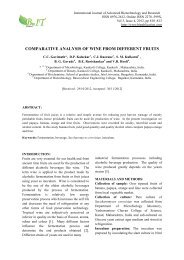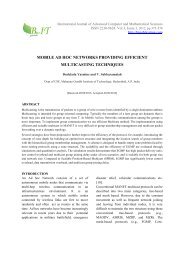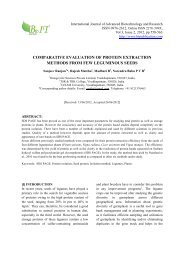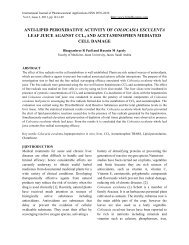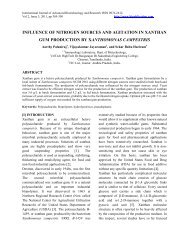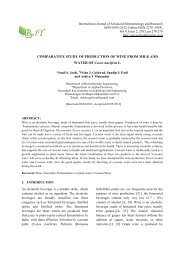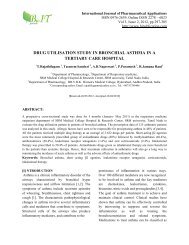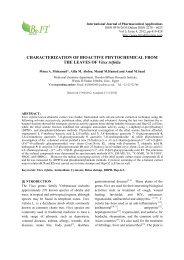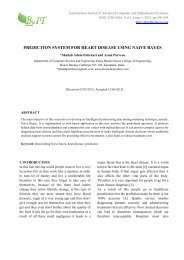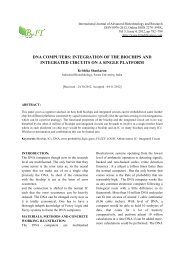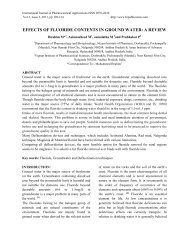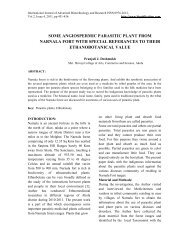SYNERGISTIC EFFECT OF CERTAIN MEDICINAL PLANTS AND ...
SYNERGISTIC EFFECT OF CERTAIN MEDICINAL PLANTS AND ...
SYNERGISTIC EFFECT OF CERTAIN MEDICINAL PLANTS AND ...
Create successful ePaper yourself
Turn your PDF publications into a flip-book with our unique Google optimized e-Paper software.
<strong>SYNERGISTIC</strong> <strong>EFFECT</strong> <strong>OF</strong> <strong>CERTAIN</strong> <strong>MEDICINAL</strong> <strong>PLANTS</strong> <strong>AND</strong> AMOXICILLIN AGAINST SOME CLINICAL ISOLATESfrom 4.25 µg/ml to 1.3 µg/ml in combination with1.25 µg/ml (equivalent to 1/14 MIC) of LGEO.The activity of Amoxacillin was enhanced 14-fold by combining with LGEO. Muroi et al. [35]reported that the activity of methicillin wasenhanced 32-fold by combining with anacardicacids against MRSA ATCC 33591.Table (6): Fractional inhibitory concentrations (FIC)values for the combination between Amoxicillin andLGEO.TestisolateFIC(Amoxicillin0.30 c a0.35 c aFIC(LGEO)FICIndexInteractionMRSA20.52 b b 0.82 a c SynergyMRSA160.56 b b 0.90 a c SynergyMRSA18 0.26 c a 0.60 b b 0.86 a c Synergy** Mean values followed by different superscript (withincolumns) and different subscripts (within rows) aresignificantly different at the 5 % levelIn this study the interpretations of activity ofLGEO combined with Amoxacillin produced asignificantly synergistic activity against the testedMRSA (M2, M16 and M18) (Table 6). Similarly,Betoni et al. [45] suggested that the lemongrassoil presented the highest synergism rate withantimicrobial drugs (penicillin, oxacillin,vancomycin, ampicillin, chloramphenicol,gentamicin, netilmicin, tetracycline,erythromycin, cotrimoxazole, and ofloxacin)against Staphylococcus aureus. The antibacterialactivity of the combinations of the ethanol extractof rosemary and cefuroxime showed synergisticeffects against all tested MRSA [26].Generally the data revealed that, LGEO hadsignificantly improved the inhibitory effects theAmoxacillin. This might indicate that the plantmaterial allowed better entrance of the drugthrough the outer layers to the cell wall, which isthe target site for this antibiotic. Variouscomponents of extracts can permeabilize the cellmembrane, increasing the penetration ofantibiotics. The interference with bacterialenzyme systems can also be a potentialmechanism of action [46]. These mechanisms ofaction can be obtained by the combination ofantibiotic with extract at a sub-inhibitoryconcentration applied directly to the culturemedium [17].Transmission electron micrographs:Transmission electron micrographs of MRSA(M2) untreated and treated with LGEO,Amoxacillin and in combination between themare presented in Fig 1. MRSA (M2) under study(without any treatment) had the typical structureof gram-positive and the cells showing an regularwall (Fig.1 A). Generally, after the bacterial cellswere exposed to the LGEO (2.5 µg/ml),Amoxacillin (4.25 µg/ml) and in combinationbetween them (1.4 µg/ml). With the treatment ofamoxicillin there was a little remarkable changein the cell morphology and cell content, but incase of LGEO and combination treatment therewas significantly shrunken and the cell size wasreduced. All treatments caused swelling of thecell wall and distribution of the cytoplasmicmembrane. In addition, cells were found to havedensely stained cell walls and irregularcytoplasmic membranes and induced emptyspaces in the cells (Fig 1 C and D).Fig. 1 C, D revealed that the LGEO affected thestructural organization of the cytoplasm morethan the cell wall of treated MRSA (M2). It mightbe proposed that in the primary phase, the testedoil probably bind the bacterial cell surface andpenetrate into the cell wall causing it to swellfollowed by cytoplasmic membrane damagewhile the cells shrink as a defense against thetested oil. LGEO is composed of severalchemical components. Its antibacterial activitymay have several targets of action on thebacterial cell. The sites of action for the LGcomponents would depend on the properties ofcompounds; some might act on separate targetsand some might be a consequence of anothermechanism. This study confirmed the mode ofantibacterial action of other essential oilscomponents which has been reviewed by Burt[10] that lipophilicity of the oil components playsan important role in penetrating the lipid layer ofthe bacterial cell membrane and mitochondriaHanan. H. Abd El-Kalek and Eman A. Mohamed 394



